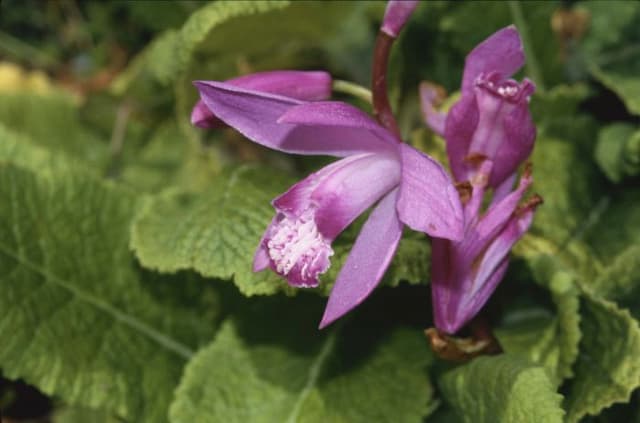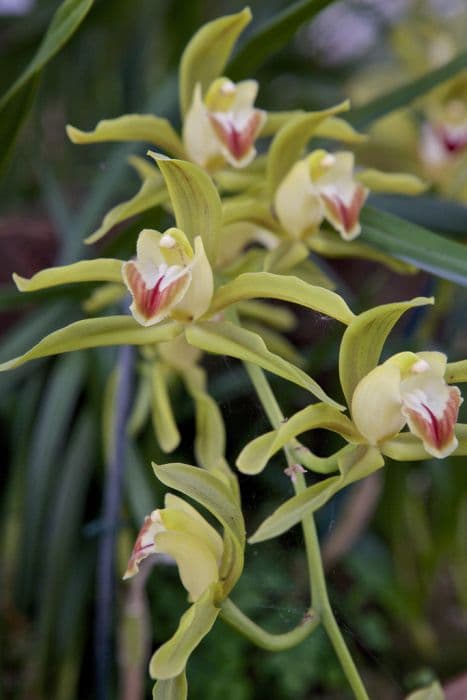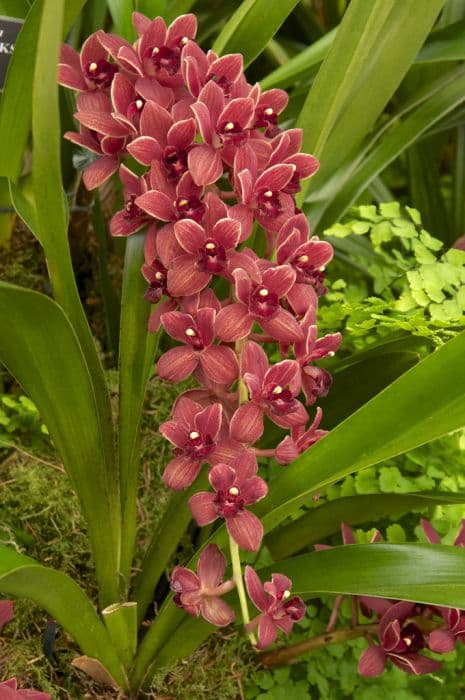Moth orchid Phalaenopsis Yellow Lightning gx

ABOUT
The Phalaenopsis Yellow Lightning gx, commonly known as the Moth Orchid, showcases a dazzling display of blooms that exude tropical charm. The petals and sepals of its flowers are predominantly a bright, sunny yellow, often graced with contrasting patterns such as streaks or spots of red or burgundy. These bold markings add an electric flair to the flower's appearance, hence the name "Yellow Lightning." Each bloom is characterized by a rounded shape with a slight overlap of petals, creating a harmonious, symmetrical look that is pleasing to the eye. At the center of each flower, the lip, or labellum, is typically more pronounced and might exhibit a different hue or pattern, which can range from a deep, inviting red to a softer pink or white touch, enhancing the overall allure of the flower. The blossoms are arranged in a loose, graceful spray, emanating from the stem, and create a cascading or arching effect that adds to the plant's elegance. The Moth Orchid's leaves are a deep, glossy green, and present a leathery texture. They emerge from the base of the plant in a compact, rosette form and are oblong with smooth, rounded edges. Occasionally, the leaves might show a slight pleating effect, which gives them additional texture. This orchid's roots are thick and fleshy, typically a silvery-green color, and they can be seen protruding above the growing medium, a common trait among orchids that adds to the plant's exotic look. Overall, the Phalaenopsis Yellow Lightning gx is a spectacular plant that brings a vibrant splash of color and a touch of the tropics to any setting it graces.
About this plant
 Names
NamesFamily
Orchidaceae
Synonyms
Moth Orchid, Phal
Common names
Phalaenopsis Yellow Lightning gx.
 Toxicity
ToxicityTo humans
The Phalaenopsis Yellow Lightning, commonly known as the Moth Orchid, is not toxic to humans. Therefore, ingesting parts of this plant typically does not lead to any symptoms of poisoning or adverse health effects. It is generally considered safe for humans to handle and be around Moth Orchids.
To pets
The Moth Orchid is not known to be toxic to pets such as cats and dogs. Ingesting parts of a Moth Orchid should not cause any symptoms of poisoning in pets, and it is usually safe for them to be around these plants without any risk of adverse health consequences.
 Characteristics
CharacteristicsLife cycle
Perennials
Foliage type
Evergreen
Color of leaves
Green
Flower color
Yellow
Height
1 foot [30 cm]
Spread
1 foot [30 cm]
Plant type
Herb
Hardiness zones
11
Native area
Asia
Benefits
 General Benefits
General Benefits- Aesthetic Appeal: Adds a pop of color and exotic beauty to any room with its striking yellow blooms.
- Long-Lasting Flowers: The blooms of the Phalaenopsis orchid can last for several weeks, providing a long period of enjoyment.
- Low Maintenance: Requires minimal care, making it suitable for busy plant owners or those new to orchid care.
- Improves Mood: Being around plants, including orchids, can help reduce stress and improve overall mood.
- Easy to Propagate: Can be propagated through keiki (baby plantlets) or division, offering the possibility to expand your orchid collection.
- Versatile Display: Can be displayed in a variety of ways—from traditional pots to mounted on driftwood or in a hanging basket.
- Gift Potential: Makes for a thoughtful and elegant gift thanks to its beauty and the symbolism often associated with orchids.
 Medical Properties
Medical PropertiesThis plant is not used for medical purposes.
 Air-purifying Qualities
Air-purifying QualitiesThis plant is not specifically known for air purifying qualities.
 Other Uses
Other Uses- Artistic inspiration – The stunning yellow blooms of the Moth Orchid can serve as inspiration for artists and designers, influencing everything from textile patterns to jewelry designs.
- Educational tool – Botany enthusiasts and teachers may use the Moth Orchid to educate about plant biology, hybridization, and the complexity of pollination mechanisms.
- Photography subject – Because of their vibrant color and intricate structure, Moth Orchids are often used as subjects for photography, helping photographers to hone their macro and portrait skills.
- Feng shui – Some practitioners use Moth Orchids in their feng shui arrangements, believing the plant brings positive energy, especially when placed in the wealth or relationship corners of a space.
- Culinary decoration – Although not edible, Moth Orchid flowers can be used as a non-toxic decoration for cakes and pastries, provided they haven't been treated with pesticides.
- Wedding bouquets – Due to their elegant appearance, Moth Orchid blooms can be incorporated into bridal bouquets or wedding decor to add a touch of luxury and exotic flair.
- Gift giving – Moth Orchids are popular as gifts, symbolizing love, beauty, and refinement, which can be particularly meaningful for Mother's Day or anniversaries.
- Perfume industry – The essence of Moth Orchids is sometimes used by perfumers to create exotic and unique fragrances that capture the essence of the tropics.
- Color therapy – The vibrant yellow of the Moth Orchid's flowers can be used in color therapy, also known as chromotherapy, to evoke feelings of cheerfulness and stimulate mental activity.
- Thematic decorations – The Moth Orchid, with its tropical origin, is perfect for creating themed environments or events, such as a tropical or rainforest-inspired party.
Interesting Facts
 Feng Shui
Feng ShuiThe Moth Orchid is not used in Feng Shui practice.
 Zodiac Sign Compitability
Zodiac Sign CompitabilityThe Moth Orchid is not used in astrology practice.
 Plant Symbolism
Plant Symbolism- Beauty and Elegance: Phalaenopsis, commonly known as the Moth Orchid, symbolizes beauty and elegance due to its delicate and exotic appearance.
- Rare and Precious: The unique Yellow Lightning variety of the Moth Orchid may represent something rare, unique, or precious in life, as this color pattern can be quite distinctive.
- Longevity and Perseverance: Moth Orchids are known for their long blooming periods and resilience, which symbolizes longevity and perseverance in challenging circumstances.
- Wealth and Prosperity: In many cultures, orchids are seen as a symbol of wealth and prosperity, and the vibrant yellow color is often associated with joy and success.
- Friendship and New Beginnings: The bright and cheerful yellow hue of the Phalaenopsis Yellow Lightning can also symbolize friendship and new beginnings, offering a sense of warmth and happiness.
 Water
WaterMoth orchids, including the Phalaenopsis Yellow Lightning, should be watered thoroughly once a week, allowing the water to run freely through the potting medium. Ensure each watering saturates the medium without leaving the plant sitting in water. If the ambient humidity is low, you may need to water slightly more often, but always let the top inch of the potting mix dry out between waterings. It's better to underwater than to overwater, as moth orchids are susceptible to root rot. Typically, use about 4-6 ounces of water per plant for each watering session, ensuring consistent moisture without waterlogging the roots.
 Light
LightMoth orchids prefer bright, indirect light, so place the Phalaenopsis Yellow Lightning near a window that receives filtered sunlight or under artificial grow lights. Avoid direct sunlight, especially during the harsh afternoon hours, as it can scorch the leaves. An east-facing window is ideal, providing gentle morning sun that encourages healthy growth without the risk of damage.
 Temperature
TemperatureMoth orchids thrive in a temperature range of 60 to 80 degrees Fahrenheit, with a nighttime drop of about 10-15 degrees to encourage blooming. The Phalaenopsis Yellow Lightning can survive minimally at 55 degrees Fahrenheit but should not be exposed to temperatures below this, as cold damage can occur. Ideally, maintain a stable environment to avoid stress on the plant.
 Pruning
PruningPrune the Phalaenopsis Yellow Lightning to remove any dead or yellowing leaves, and spent flower spikes can be cut back to just above a node to potentially encourage a secondary bloom. Pruning is typically done after the bloom cycle is complete. Inspect the plant regularly and prune as necessary to maintain its health and appearance.
 Cleaning
CleaningAs needed
 Soil
SoilThe best soil mix for Moth Orchid (Phalaenopsis Yellow Lightning gx) is a well-draining orchid potting mix, often composed of bark, sphagnum moss, and perlite. The ideal soil pH should be mildly acidic, ranging from 5.5 to 6.5.
 Repotting
RepottingMoth Orchids should be repotted every one to two years or when the potting medium begins to decompose, to ensure the health and vigor of the plant.
 Humidity & Misting
Humidity & MistingMoth Orchids thrive best in environments with 40-70% humidity, which supports their tropical nature and growth requirements.
 Suitable locations
Suitable locationsIndoor
Place Moth Orchid in bright, indirect light; ensure high humidity.
Outdoor
Moth Orchids generally don’t fare well outdoors due to variable conditions.
Hardiness zone
Moth Orchids are not indeed categorized in USDA hardiness zones as they are tropical and typically grown indoors.
 Life cycle
Life cyclePhalaenopsis Yellow Lightning gx, commonly known as Yellow Lightning Phalaenopsis, begins its life as a seed that requires a specialized fungal partner to germinate, as orchid seeds lack nutrients. Once germinated, the seedling grows slowly, developing leaves and roots over a few months to a few years, depending on conditions. When mature enough, it forms a vegetative clump with several leafy stems, and under suitable light and temperature, it develops a flower spike. The flower spike elongates and buds form, which then bloom into the characteristic vibrant yellow flowers. After pollination, which may occur naturally or be facilitated manually, the plant can produce seed pods that take several months to mature, completing the reproductive cycle. In absence of pollination, the flowers wither and the plant may enter a period of vegetative growth before attempting to bloom again.
 Propogation
PropogationPropogation time
Spring-Early Summer
The Phalaenopsis Yellow Lightning gx, commonly known as the Moth Orchid, is typically propagated through the division of its rhizome or offshoots (keikis) that form on the flower stalk or from the base of the plant. This is usually done when the plant is being repotted, which is best performed after the orchid has finished blooming and new growth is visible. During repotting, the grower carefully separates the offsets that have their own roots and at least two to three leaves, or divides the main plant by separating it into sections, making sure each section has at least three healthy roots and a leaf. These sections or offsets can then be potted into their containers filled with an appropriate orchid potting mix. Care is taken to maintain high humidity and adequate but indirect light to encourage the new plant to establish itself.








